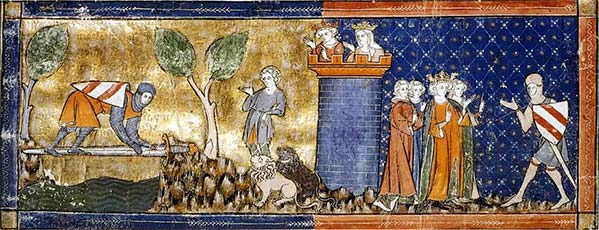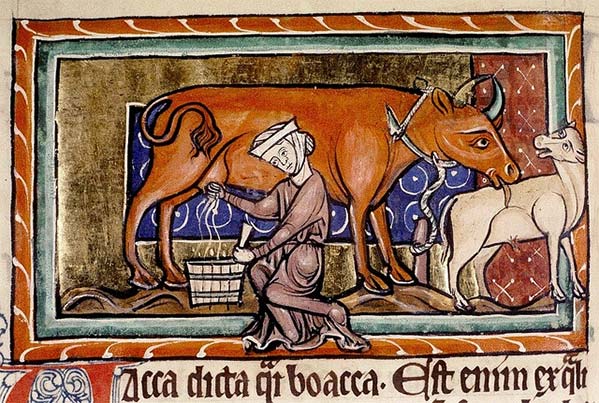Anselm of Canterbury (1033-1109)[1] – considered by some to be one of the greatest Christian thinkers – wrote a much loved book called ‘Cur Deus Homo’ – ‘Why Did God become Human?’ In this he has a dialogue with one of his students, who goes by the superb name of ‘Boso’. Boso wants to understand the doctrines of Christianity, and I therefore consider him my rightful ancestor. He is a clever chap, trained in philosophy – which is where, on both counts, the relational similarity between us breaks down.
Anyway, Anselm sets out to explain various Christian doctrines in as easy a way as possible.[2]

Like all the best teachers he strives to make his content as relevant to everyday life as he can, using examples that people could relate to. Right at the start of his books, there ended up being two, he begins by saying that he is has been ‘earnestly requested’ to ‘hand down in writing the proofs’ of the beliefs of Christianity. He adds that he is often asked this, and that his people say the ‘proofs’ he gives in response ‘gratify them, and are considered sufficient.’ He sums up by saying that his purpose is that people ‘may be gladdened by understanding‘ and ‘always ready to convince’ people who in turn ask them for ‘a reason of that hope which is in us.’ So Anselm had a pastoral heart. This ‘gladdened by understanding’ chimes with me – that was my experience of 5 years of theological study.
Its Very, Very Cultural
Just as we saw with the ‘cosmic battle’ in the Christus Victor theories we again see influence of cultural settings on peoples’ understanding of the cross. Anselm lived in the early middle ages, about which I remember doing a project in primary school, and have watched Robin Hood… So I was pleased when it turned out that one member of my study group knew masses about it, and told us in detail about Chaucer and various Knights of the Round Table. And better still, she set the scene brilliantly for what followed, expanding the research I had done.
In Anselm’s day society was very structured (any change today?). Honour and satisfaction were very important, and there were clear expectations surrounding these. The Lord provided protection and capital to the serfs, and the serfs gave loyalty, tribute and honour. If a serf did not fulfill his duties the Lord was ‘offended’, and something needed to be offered to satisfy thatoffence (even if the Lord didn’t want anything – it was like a legal requirement). It was considered the Lord’s right to require satisfaction, and it was therefore expected. The amount of satisfaction depended on both the nature of the crime, and on the status of the Lord. The higher up the social structure the offended party was, the more the redress.[4]

On top of this emphasis on the giving of offense, and the necessary satisfaction to redress the perceived damage to a person’s honour, the religion of the time placed great weight on the wrath of God. The people were afraid of God, and in this climate penances seemed a natural response. If you sinned, you could pay back the damage by some act of repentance. Additionally, you could store up credit for use in the future, or for making satisfaction for the sin of someone else.[5] Anselm spoke into all this, taking the ideas of honour and debt and applying them to the work of Jesus.
Anselm’s view of sin was a more refined than this however, as he looked for a root cause which he saw in total lack of the giving of our wills to God. Since God created and sustains all things God had a right to our total obedience, and therefore we offended his honour.[6] This offense to God’s honour is our sin. Just as with the Lords and Serfs of his day, humans need to offer something to God to make reparations for the debt of honour that we carry due to our self asserting wills. So it is abundantly clear that Anslem is adapting his culture to develop his view of the cross.
Naturally enough, God being God, the size of the debt owed is astronomical and can never be paid. This is only exacerbated by the fact that all of our will is turned against God. [7] So, reasons Anselm, only an offering made by a perfect human will be of sufficient standing too satisfy the damage to God’s honour. Hence the coming of God as a human.[8] As such, Jesus could build up enough of a credit as it were to cover all of us.
Strengths and Weakness
There are a lot of strengths and weaknesses with Anselm’s satisfaction theory, as it is known. If you have been around churches in the UK you will have heard some of the language around the debt owed by sinners, and paying it back. Interestingly, given the prevailing climate of fear, one of the great strengths of the theory is that God is not portrayed as wrathful requiring punishment for sin. This is because his idea is transactional – the law requires a debt to be paid – and as such is free of emotion. It is not about placating and angry deity[8].
On the other hand, the ‘what I need is being paid by someone else’ theory is somewhat lacking on the relational side since it does not develop a human’s interaction with God. Sure, the sinner is pleased that their debt is cancelled – but that is not the end of things in itself. The NT talks about freedom from slavery leading, as the grip of sin is released, to a change in our inner nature, rather than a one time payment for satisfaction and honour satisfaction.
Another really pressing positive is that Anselm has taken something in his culture and used it to explain atonement, something which the NT writers clearly did it too.[9] However, some see this as a weakness, because Anselm has used his culture to interpret the bible – and taken it too far, modelling God in the likeness of a Lord, and making honour a really, really big deal. Personally, I don’t really see this. How can I offend a God who knows everything about me? Is that even possible. If God could humble himself to take the form of a servant, then it seems to me that almighty God is not that concerned about his honour.(Phil 2:7)
I am not so sure about this’ culture incorporation‘ as a weakness. I am working through ideas around the gospel and cultural relevance, and becoming more aware that all the models are metaphors and as such not exact descriptions of how the atonement works. So while the satisfaction theory has issues, is there something to be said for Anselm’s method? If so, is there room for some new metaphors today? Or is it more about letting an existing metaphor rise to the surface? Something around identity? Ecology?
So I find Anselm deeply inspiring and want to ask to what extent should we, or indeed do we, follow Anselm’s lead?
References
- Anselm of Canterbury, Wikipedia, https://en.wikipedia.org/wiki/Anselm_of_Canterbury, accessed 12/10/2019
- Anselm, Cur Deus Homo, http://www.saintsbooks.net/books/St.%20Anselm%20of%20Canterbury%20-%20Cur%20Deus%20Homo.pdf, book 1 chapter 1, accessed 10/10/2019
- Green, Joel B, Baker, Mark D, Recovering the scandal of the cross: Atonement in New Testament and Contemporary Contexts, (CITY, IVP, 2011) p reference coming
- Green, Baker, Scandal, p reference coming
- Green, Baker, Scandal, p reference coming
- Anselm, Homo, 1:11.
- Anselm, Homo, 1:23
- Anselm, Homo, 1:12
- The NT talks about the sacrificial system. This means very little to us today, but if Hebrews was written for a Jewish audience, clearly they would understand it.



